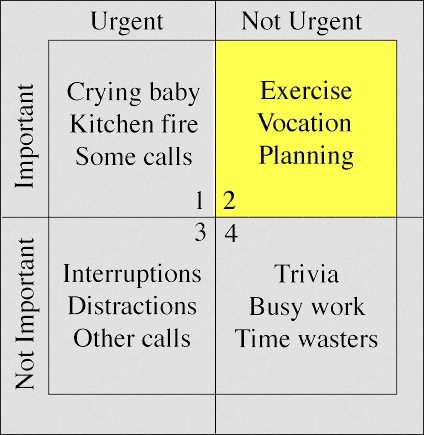In The 7 Habits of Highly Effective People, Stephen Covey put forth the idea of viewing tasks through the lens of importance and urgency. The idea, proposed in the section entitled Habit 3 Put First Things First, is that one should align one’s actions with “First Things” to achieve effectiveness. Covey presented the following matrix, sometimes attributed to President Eisenhower, to illustrate the point. The matrix breaks tasks down into the four combinations of urgent, important, not urgent, and unimportant.

Covey later expanded on this idea, with coauthors A. Roger Merrill, and Rebecca R. Merrill, in the 1994 book First Things First, a book that elaborated on Habit 3 and focused on time management. In this book, he offered up a more graphical version of the time management matrix.

In case you were wondering, Quadrant 2 is what separates Hero-ClassTM organizations from the rest.
The reality of modern business is that the urgent gets done. Sometimes, what’s urgent is important; other times it’s not. But urgent is where we tend to live, both in organizations and in our personal lives. Digital phones, email, text, social media — we are never more than one electronic blip from the next distraction, the next urgent but unimportant item.
Worse, immediacy is often confused with urgency. Why do you feel the need to respond to that email immediately? If you had not checked email today, would it have been acceptable to answer that email tomorrow morning?
We’ve all been there.
Even if we can manage not to confuse immediacy with urgency, there is plenty of urgency to take up all of our time, and it does so at the expense of the important items that are the true difference between good and great organizations.
In customer service and customer experience, Quadrant 2 can represent a whole host of important items that tend to get subsumed by the urgent:
One phrase I’ve been using for years to tell other stakeholders why I’m not taking action on something is the following:
I’m putting out the fires closest to my feet.
Ironically, I just blurted out the phrase during a discussion one day, but I liked it and have been using it ever since. I find it to be a nice, metaphorical way of saying: your problem is tomorrow’s problem; I’m focused on today’s problem.
While this might seem like a call to prioritize the urgent, it actually works very well with the decision matrix above. Why?
Because not all fires are created equal.
To extend the metaphor, the fire closest to your feet could be a road flare burning next to a bucket of gasoline (urgent and important) or a match burning on top of a snowball (urgent and unimportant). The Quadrant 1 fires require immediate focus and attention. The Quadrant 3 fires need to be delegated, addressed in batches, or ignored completely.
The challenge in modern organizations (and lives) is that the nature of always-on connectivity has made it increasingly more likely that the urgent will subsume the important. Quadrant 3 tends to crowd out Quadrant 2.
This dynamic tends to manifest itself simply in customer-facing organizations:
More than ever, our organizations need to find ways to focus on Quadrant 2, to focus on things that are important but not urgent.
If you want to ramp up the effectiveness of your organization, simply dedicate focused time at the beginning of each week to determine which are the important but not urgent items you want to execute on that week. Then, find a system that allows for those focus areas to stay top of mind for you and your team.
Make sure to come back on Thursday for part two of our unofficial Stephen Covey week: Sharpening the Organizational Saw.
Comments are closed.
© 2011-2025 CTS Service Solutions, LLC.
All rights reserved.
Legal Information | Privacy Policy
How to Cite this Site
Pingback: 3 Themes for National Customer Service Week 2016
Great post, Adam! Thanks for sharing. Defining if tasks are urgent or not, or important or not, is important. This helps teams get more effective and productive.
I especially agree with what you said: “f you want to ramp up the effectiveness of your organization, simply dedicate focused time at the beginning of each week to determine which are the important but not urgent items you want to execute on that week.” Preparation is key.
A colleague of mine at Tenfold told me that failure to prepare is preparing to fail. Being ready is a good thing since reps can condition and ready their body and mind to produce results.
Thanks so much Brooke! “Failure to prepare is preparing to fail.” So true!